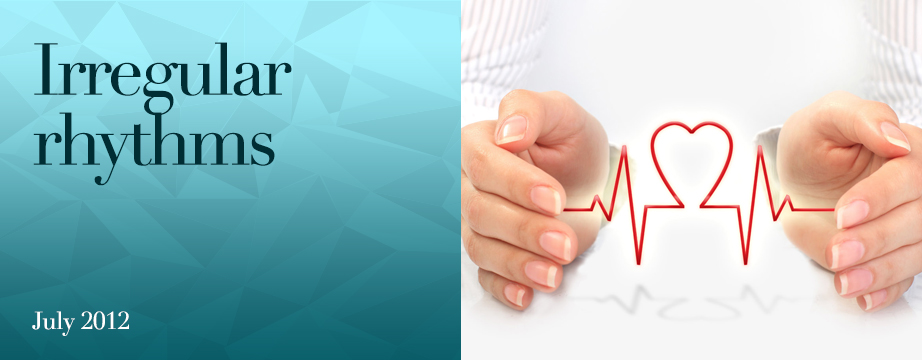
| AtrIAl fIbrIllAtIon (Af) IS A HeArt-rHytHm dISorder In wHIcH tHe Upper chambers of the heart (the atria) are totally disorganised (much like a bag of worms) because the atria are contracting at a rate of 450-600 beats per minute, whereas the lower chambers (the ventricles) are contracting irregularly at a rate that varies from beat to beat. This can range from 40 beats per minute to more than 200 beats per minute. |
| Atrial fibrillation is a disease that can present with no symptoms. So how does one know if he/she has it? Most of the time, the patient will have symptoms when it occurs because the heart rate will suddenly be irregular and even very rapid. The patient will experience palpitations, which manifests as an awareness of the heartbeat. Sometimes this will be accompanied by shortness of breath, giddiness or sudden chest discomfort. When the condition is chronic, the patient may present with further complications, which can include things such as stroke or heart failure. |
| There are many causes of atrial fibrillation. Some of these causes include ageing, high blood pressure, hyperactive thyroid, lung disease, coronary artery disease, cardiomyopathy, alcoholic binging and congenital heart defects. Some are idiopathic – meaning they have no heart disease and we are unable to identify any known cause. |
| Treatment is available for this condition. Treatment is directed towards prevention of the atrial fibrillation itself and prevention of complications such as stroke. For stroke prevention we can prescribe medicines like aspirin, clopidogrel or warfarin. There are also some new oral anticoagulants on the market, like Rivaroxaban. For prevention of the condition drugs or radiofrequency catheter ablation are the two options available. In some cases electrical cardioversion is sometimes used to stop an acute attack and get the patient back into normal rhythm immediately. |
| It’s possible and usual to experience some relapses after treatment. Some patients may be controlled with drugs alone, meaning that they get the attacks less often and for shorter periods of time. However it is usual to expect some recurrence even after drug treatment. The drugs do not cure the condition. With catheter ablation, the recurrence rate is aproximately 30-35 per cent – this is without the use of drugs after ablation. But with the additional use of drugs, recurrence can often decrease to 15-20 per cent. It is not unusual for the patient to require more than one ablation procedure to achieve a more lasting and successful outcome. |
| Pre-ablation, a transesophageal echocardiogram and a CT scan of the heart isrequired to check if there is any clot in the heart chambers (this is a contra indication for ablation) and to check the size and position of the pulmonary veins, which are the common sites of origin of the atrial fibrillation. Post ablation the patient should take warfarin or an equivalent blood thinner to prevent blood clots in the heart chambers for at least three months. Anti-arrhythmic drugs are usually maintained in the first three months until reassessed by the cardiologist as to whether they can be stopped. It is also common during the first three months to experience a recurrence of the atrial fibrillation as the heart will still be healing after the ablation. |
| Unfortunately there is no simple way to prevent atrial fibrillation, as ageing is inevitable. Since atrial fibrillation is a disease of ageing, it is more common as one gets older. However, good control of hypertension may lesson the incidence. |
 DR RUTH KAM
DR RUTH KAMCardiologist
MBBS (Singapore)
MRCP (Int Med) (UK)
M Med (Int Med) (Singapore),
FAMS (Cardiology), FRCP (Edin)
Ruth Kam Heart and Arrhythmia Clinic
1 Farrer Park Station Road, #07-11 Connexion
Farrer Park Medical Centre, Singapore 217562
Tel: 6443 0468
www.arrhythmia.com.sg
1 Farrer Park Station Road, #07-11 Connexion
Farrer Park Medical Centre, Singapore 217562
Tel: 6443 0468
www.arrhythmia.com.sg



